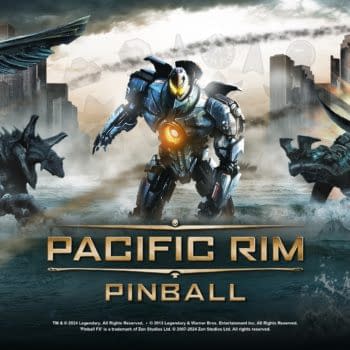Posted in: Board Games, Games, Review | Tagged: flatline, game review, Renegade Games
Saving Patients As Best We Can In The Future With 'Flatline'
Keeping people alive is a terrible job for people who have no expertise in anything medical. I've played my fair share of games revolving around being a doctor and playing surgery, dating back to Operation all the way to Surgeon Simulator. I learned right away that medicine was not my strong suit. So whenever another game revolving around keeping people alive comes my way, I like to seek out help from people who have some sense of compassion and organization. Which made getting my friends together to play Flatline by Renegade Games the perfect fit for a review. (Special thanks to Doug, Sara, Allison, Josie, and Mike for their help in this review as we played it at The Watchtower Cafe in Salt Lake City.)
Flatline is a cooperative dice game that puts you and your friends in the position of being medical doctors in the future. The game is actually called Flatline: A FUSE Aftershock Game because it's based in the same universe as FUSE, with the premise that some of the bombs you didn't defuse have gone off and now you have patients to treat. The game goes up to five players, and trust me, you'll need five players to handle the crisis set before you. The board fits together like a puzzle with a rotating disc in the middle and four bio-beds for your patients to lay down in for recovery. Using the dice each of you is given, you'll roll to see what you have as far as resources to treat emergencies, incoming triage, and the four primary patients in your beds.
The game has a time limit based on the amount of green cubes you have placed in the timer area. There's a normal side and an emergency side if you wish to add more difficulty. One of you will act as the medical chief that keeps time and makes certain decisions. That person will pick another to serve as the intern in helping keep track of certain actions in the game, while the rest simply serve as other medical staff. Play starts by drawing five cards from an emergency pile and placing them where they need to go int he blue or orange areas. You then roll the two white dice to see which numbers need to be taken care of immediately from the blue area. These cards need to be dealt with, followed by the orange, then your patients.
At this point, you'll roll your dice to see what resources each doctor has. Each die has one of six symbols on them: stitches, stethoscope, monitor, clipboard, watch, and pencil. You will use these resources to treat the cards and the patients simultaneously, but always taking care of the cards first before the patients. You have one minute to scramble your resources and fill out as many of the squares as possible. If you fill out a card, it gets moved to the green area and you can use the benefit from the card to help you later in the game. If you fail to take care of a card, it goes into the red area and goes against you toward losing the game.
After the cards are dealt with, you can then treat patients. On each patient, you'll see a line of "issues" that need to be dealt with. On each line, you'll see a doctor symbol letting you know that one doctor, two doctors, multiple doctors, or all doctors can or have to contribute resources to a single area to help cure the patient of that line of problems. If you manage to cure a single line, the intern then covers that line up at the end of play and that patient is treated for those symptoms. If there aren't enough resources, they are lost and they are still sick or wounded in that area next round. Again, you're still under a one-minute timer, which means anything you don't use goes to waste.
The rounds go by quickly and play a lot like FUSE on drugs. You'll be making a lot of snap decisions on what you do and how you accomplish it without stepping on each other's toes or failing to use resources the wrong way. At the end of the round you move whatever cards you cured or didn't cure to their appropriate areas, cover lines on patients that were cured, take back all your dice, remove one green cube from the timer and start the next round. It is possible to get new green cubes to add additional time by filling up certain areas on the board, but that's a bold decision that uses six resources and could hinder your progress. But those are the risks you'll need to take.
The game is a pain to play at times as you are constantly stuck with the wrong resources to treat certain patients or cards. A frequent occurrence we would run into is having an orange card that needed to be treated a certain way be lost due to not having the right resources, and we were forced to take the penality. There's no real way to deal with it other than to accept fate, which if you're a doctor is part of your job, but as a player is totally unacceptable. I liken it to playing Mega Man for the first time where you learn levels by getting hit and having to play them over and over until you memorize how to get it right. That can be a trial on the mind and make the game not so fun when you're forced to take a penalty for something you couldn't take care of.
You win the game by treating all of the patients, depending on how many you needed to draw for your particular level of play and number of doctors you're working with. For us, we failed. Primarily because it was everyone's first time playing and we were getting used to the rules, but for a long period of time were doing exceptionally well and cured nine of the thirteen patients we needed to treat before succumbing to being overridden with emergencies that ultimately ended the game.
Flatline is kind of a badass little game, but it isn't for the timid. There's a lot to take into account of what you need to accomplish and the timer will add stress to the decision making. I recommend going at least one game without the timer being a factor and just see how well you can work as a team before diving in and playing it for real. I highly recommend it for dice junkies and people who dig cooporative party games. There are some people who won't dig the stress involved, but honestly, it adds a factor of challenge to the game you don't see too often in other dice games.


















